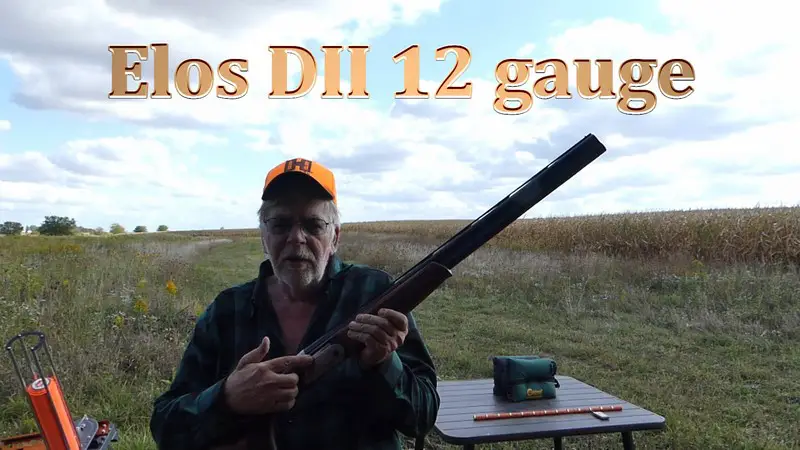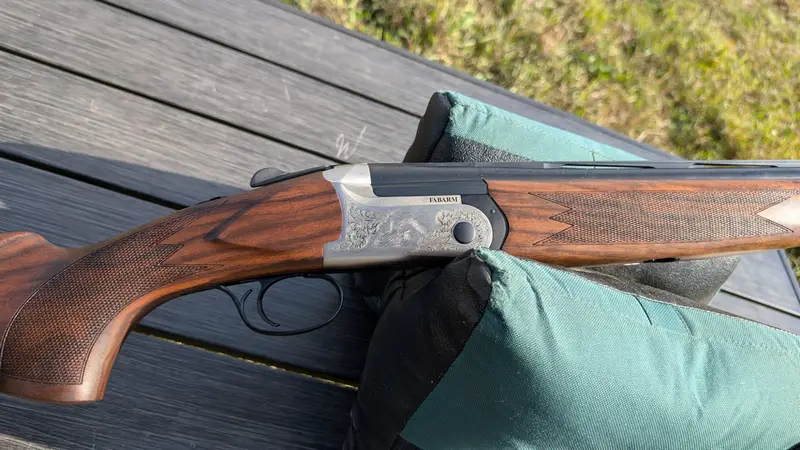|
The Truly Light Twelve: Fabarm Elos D2 Over / Under

The “light” moniker has been around for countless years. The Browning A-5 Light Twelve was cataloged at 7 lbs., 10 ounces. When production moved to Japan, the 'light' A-5 got remarkably un-lighter. My DU Light Twelve example weighed 8-3/4 lbs. with a fixed modified choke. Jack O'Connor remarked that he would not use any shotgun that weighed more than 7 lbs. for upland hunting. This Fabarm Elos D2 12
gauge with 28 inch barrels weighs in at 6 lbs., 6.5 ounces.
The triggers break at a crisp 4-1/2 pounds. My sole
complaint with this example is the overly stiff tang safety:
I'd ask Fabarm to lighten it up if this was my gun. Fabarm
USA calls this shotgun a “D2,” but DII is engraved on the
bottom of the receiver: either way, it is a “dee-two” O/U
with an Ergal 55 alloy nickel-plated receiver.

The D2 12 gauge weighs less than many 20 gauges, for example: Browning Cynergy Field, O/U, 28 inch barrels, 6-3/4 pounds. Browning Gold 20, 26 inch, 7.0 pounds. Browning Silver Hunter 26 inch, 6.5 pounds. Ithaca M37 Featherlight, 26 inch barrel, 6 pounds. 13 ounces. Remington 1100 Sporting, 28 inch barrel, 8.0 pounds. Remington 870 Wingmaster Classic, 26 inch barrel, 6 pounds, 7 ounces. Years ago, picked up an uncommonly nice Browning Citori Grade II, with 26 inch barrels, and fixed Modified / Full chokes. While it was a beautiful gun, it weighed 8 pounds on the nose. I quickly tired of lugging it through the pheasant fields. The kiss of death for alloy receiver vertical doubles is often excessively heavy barrels. Apparently, anyone can make a heavy barrel set which destroys balance, shouldering, and handling. Fabarm's Tri-Bore barrels are light and lively, as well as being CIP over-proofed to 1630 BAR. This eliminates the opossum on a rake balance that people loathe. As with all Fabarm shotguns with TriBore barrels, you can use steel shot through factory choke tubes up to the 9/10 “Full” choke. Regardless of brand, fixed breech guns have recoil
in concert with their weight. Rearward force of the gun is
essentially the same for this 6 lb. 6.5 ounce shotgun as any
other shotgun, regardless of brand, regardless of gauge. The
difference when using shells of the same payload and
velocity is the human factor. A gun that fits you better, a
gun that has a more generous recoil pad, and when you wear
thicker clothing or padded hunting or shooting vests all
make the guns more comfortable to shoot. 
The reason you might opt for a 6-1/2 lb. class O/U 12 gauge is cheaper shotshells and more load versatility. There is a “gauge tax” on shotshell ammo other than 12 gauge. You can expect to pay 10-15% more for 20 gauge ammo, but going with 28 gauge or .410 bore may run you 60, 70, or 90% more in ammo costs even though you get less payload. A case of 2-3-/4 inch 28 gauge ¾ oz Super-X loads costs $190 from one retailer, 7/8 oz. Fiocchi loads are $230 per case of 250, yet 1-1/8 oz. 12 gauge loads are $99 from the same vendor. A 90% upcharge is off-putting: more than enough to keep me away from 28 gauges, although I still own one. Some folks feels that they shoot 12 gauges better than other gauges, others just want to standardize their hunting guns to one gauge. Like most things, it is a matter of choice. If you want a 6-1/2 lb. Fabarm O/U, you can go with a steel receiver Elos 2 Elite 20 gauge, or this alloy 12 gauge DII. If you want lighter yet, this same DII in 20 gauge gets you to under the 6 lb. mark: https://chuckhawks.com/fabarm_ELOS-D2_2024.html . As with all Fabarm USA
DII's, you get a padded, zippered case, five flush choke
tubes, and a five year written warranty. More info is at https://fabarmusa.com/ .
|